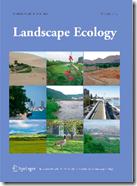New article: Recent fire history and connectivity determine bird distribution in landscapes dominated by land abandonment
In a new article published in the journal Landscape Ecology, members of the ECO-LAND lab led by Elena Lopez-Zozaya have analysed how landscape history and the pattern of recent fires determines the distribution dynamics of early succesional bird species in Mediterranean landscapes driven by land abandonment of less productive areas and an increase in wildfire impact.
More specifically, the team tested the hypothesis that fires occurred in recent decades drive the pattern of expansion of early-successional, open-habitat bird species by aiding in the process of colonisation of newly burnt areas. The results suggest that land use changes in recent decades have produced a shift in the relative importance of habitats acting as reservoirs for open-habitat bird species dynamics in Mediterranean areas. Before the middle of the twentieth century species’ reservoirs were probably constituted by relatively static open habitats (grassland and farmland), whereas afterwards they likely consist of a shifting mosaic of habitat patches where fire plays a key role as connectivity provider and largely contributes to the maintenance of species persistence.
The study was carried out in Catalonia (NE Spain) and selected 44 burnt sites occurring between 2000 and 2005 to model colonisation patterns under different assumptions of potential colonisers’ sources and evaluated the colonisation estimates with empirical data on six bird species especially collected for this purpose. The team first defined three landscape scenarios serving as surrogates of potential colonisers’ sources: open-habitats created by fire, shrublands and farmlands.
The we used a parameter derived from a functional connectivity metric to estimate species colonization dynamics on the selected sites by each particular scenario.To finally, evaluate our colonisation estimates with the species occurrence in the studied locations by using generalized linear mixed models. The occurrence of the focal species on the newly burnt sites was significantly related to the connectivity patterns described by both the recent fire history and the other open-habitat types generated by a different type of disturbance.
——————————————-
Impacte històric del foc a nivell de paisatge sobre la distribucions de d’ocells d’hàbitats oberts
En un article recent publicat a la revista Landscape Ecology, membres del laboratori ECO-LAND , encapçalats per Elena López-Zozaya, han analitzat com la història del paisatge i el patró d’incendis recent determina la dinàmica de distribució de dels usos tradicionals i els incendis forestals.
Més específicament, l’equip va testar la hipòtesi que els incendis ocorreguts en les últimes dècades determinen el patró de colonització d’espècies d’aus de hàbitats oberts. Els resultats suggereixen que els canvis d’ús del sòl en les últimes dècades han produït un canvi en la importància relativa de la tipologia d’hàbitats que actuen com a reservoris d’espècies obert hàbitat. Abans de mitjans dels segle XX, les espècies estaben probablement determinades per la distribució d’hàbitats oberts de caràcter relativament estable (pastures i terres de cultiu), mentre que l’actualitat el mosaic canviant de taques d’hàbitat derivats del foc juga un paper clau en la persistència de les espècies.





